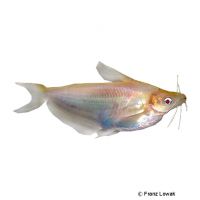Albino Silver Butter Catfish (Schilbe intermedius 'Albino')
| Albino Silver Butter Catfish Schilbe intermedius 'Albino' | |
|---|---|
| Name | Albino Silver Butter Catfish |
| Name Lat. | Schilbe intermedius 'Albino' |
| Family | Schilbid Catfishes |
| Family lat. | Schilbeidae |
| Order | Catfishes |
| Order lat. | Siluriformes |
| Origin | Africa |
| Habitat | Lakes |
| Diet | Omnivore |
| pH | 6.0-7.5 |
| Behavior | Peaceful |
| Keeping | Group |
| Care Level | Moderate |
| Reproduction | Egg scatterer |
| Breeding | None reported |
| Life Span | 5-10 years |
| Protection | No |
| Metric Units | |
| Size | 30 cm |
| Temperature | 23-27 °C |
| Hardness | 5-15 °dH |
| Aquarium | 400 l |
| US Units | |
| Size | 12" |
| Temperature | 73-81 °F |
| Hardness | 89-267 ppm |
| Aquarium | 100 gal |
Distribution and habitat
The albino silver catfish is a color morph of the silver catfishes, which are widely distributed in tropical West and Central Africa to the north of South Africa. They are mainly found in lakes, rarely in rivers, with muddy soft bottoms and dense underwater vegetation, where they stay in small shoals in the open water.
Maintenance
They require an aquarium with dense perimeter planting that reaches the surface, with roots that serve as shelter and retreat, and plenty of free swimming space. A dark, soft substrate covered with some foliage (sea almond tree, oak), subdued light (floating plants) and clear water with a weak current is ideal.
No ammonia, ammonium and nitrite should be detectable, the nitrate value should not exceed 100 mg/l. To ensure the water quality and oxygen content, a filter and heater adapted to the aquarium size is required, as well as lighting for the species-appropriate day-night rhythm of the animals.
Diet
They are uncomplicated in their diet. The food offer consists of high-quality dry food for catfish (tablets, granules, pellets) supplemented with daphnia, mosquito larvae, tubifex, shrimps, earthworms etc., which is also accepted in frozen form without problems. Plant seeds and fruit are also eaten with varying degrees of pleasure.
A regular and varied diet promotes health and prevents deficiency symptoms. Only as much should be fed as is eaten immediately (in a maximum of 10 minutes).
Behaviour and compatibility
They are swimming, peaceful fish that like to stay in a shoal. At least 5, but preferably more should be kept together. Individuals remain shy and become stunted. They are well suited for a community tank with calm, peaceful fish. Fish that are too small are considered prey. Basically, only compatible fish species with similar demands on water condition and water temperature should be socialized.
Sex dimorphism
No external distinguishing characteristics are known. The females are slightly larger and appear more rounded than the males.
Reproduction and breeding
During the rainy season they migrate up the rivers where they spawn in pairs or groups over aquatic plants. There are no known reports of successful breeding in the aquarium.
Important
Silver catfish, which grow up to 35 cm in size in the wild, are an important food fish in their range and are also farmed in aquacultures
When catching them, fine-meshed nets should be used as far as possible so that the hard rays of the pectoral fins do not get caught.
The well-being of the fish should be checked regularly. Temperature should be checked daily, pH, hardness and nitrate levels at least every 14 days. Regular partial water changes are recommended, even if the contaminant level has not yet reached the upper limit. Sudden changes in water quality should be avoided. Newly introduced fish must be accustomed slowly to the water in the aquarium.
Further literature can be found in your pet store.
References
Text: petdata; Image: Franz Lowak
Source: BMELV (1998): Tierschutzgutachten - Haltung von Zierfischen (Süßwasser); RIEHL & BAENSCH (2006): Aquarien Atlas Bd. 1, Mergus Verlag; ENGELMANN (2005): Zootierhaltung - Tiere in menschlicher Obhut: Fische, Verlag Harri Deutsch
- Gemäß § 21 Abs. 5 Tierschutzgesetz idgF
